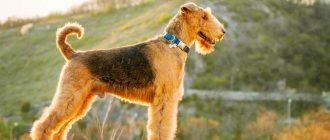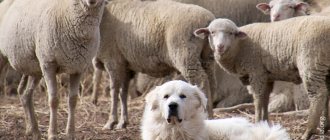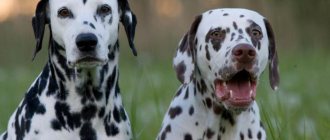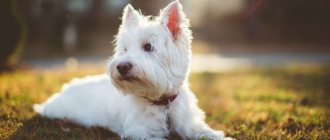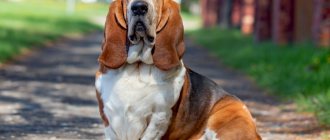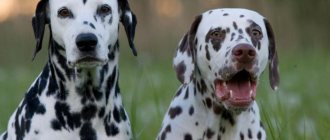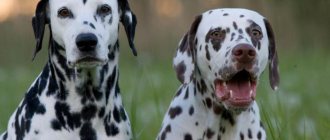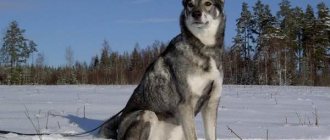Greyhound breeds were specially bred for hunting, especially the Greyhound variety. The main task of these dogs is to bait game, so they have high endurance and long legs so that they can quickly overtake their prey. For hunting in open areas, this breed is better suited than other hounds due to the speed with which they can run.
The physical features of the Greyhound's skull (namely, its elongated shape) indicate that the dog has a wide view of the area. It is this feature that distinguishes this breed from ordinary hounds.
Other characteristic features that the Greyhound has include lean muscles, a thin body, and long forearm and lower legs. You can hunt with such a dog on:
- wolves;
- hares;
- fox;
- any ungulates.
On average, the speed of an animal can vary between 49-61 kilometers per hour.
From the history of the appearance of greyhounds
The greyhound dog appeared and spread throughout all countries starting from Arabia, where the breed was bred back in the times of Mesopotamia or Ancient Egypt. Scientists have found a lot of evidence that greyhounds existed back in 4000 BC. Drawings and various kinds of images were found later, and scientists found skeletons of such animals in tombs.
The breed penetrated the territory of the Caucasus along with military and trade campaigns through Afghanistan and other countries, then, over time, the famous Russian greyhound was bred on its basis. But these dogs came to Europe through Syria. It is known that even Alexander the Great loved such dogs and brought them specially from Gaul.
Interesting Facts
Hunting dogs: breeds, small and large types
The most plausible version of the origin of the hounds is Africa. It was there that rock paintings with greyhound-like animals were discovered. Moreover, figurines and mummies of similar dogs were found in the tombs of the pharaohs.
According to another version, the breeding and use of dogs of this breed in hunting is attributed to the territories of Asia Minor and Central Asia.
There is also information about hunting with greyhounds in the European part of Russia as early as the 11th-12th centuries. True, more reliable information about this goes back to the 15th century.
Horse hunting with greyhounds
Hunting by baiting has always been perceived not only as a way to obtain the necessary meat and skins, but also as a kind of sport. Among equestrian peoples this was one of the most common entertainments. And in general, for many centuries it was customary to go hunting on horseback. This kind of entertainment was practiced not only in Europe, but also in Asia and Arab countries. At that time, greyhounds were no less popular than birds.
In Rus', such entertainment was available only to princes and boyars; it was such an expensive hunt that became the main reason why the Russian greyhound received special attention among other hounds.
There are facts in history that suggest that in England there was a time when ordinary people were prohibited from owning this elite breed of dog, so that they would not join in the hunt and interfere with the entertainment of the upper class.
Reviews
Oleg, 22 years old: “Since childhood I dreamed of a dog, I chose a Russian greyhound. When purchasing, I took two three-month-old females at once. I don’t regret anything, even though I’m not a hunter. Greyhounds require special care, but shortcomings are compensated by affection, intelligence and good manners. When training a dog, you cannot beat it, otherwise there will be resentment and misunderstanding, and sadness immediately appears in the eyes.”
Vladimir, 46 years old: “My friends have an Irish wolfhound. I am amazed at the devotion and self-sacrifice of these dogs. Once we were walking in the forest, and Jack took the bear away from us. Despite all attempts to call the dog, the barking only became more distant. Later they found bear tracks, and the family member himself returned a day later, pretty exhausted.”
Alina, 34 years old: “We purchased an Afghan hound and we are very sorry. The dog needs a lot of quality care, regular brushing and training. The dog is difficult to train, and it will not work to put on a muzzle in public places, since if the greyhound tilts its head, it will simply fly off. From my own experience, I will say that it is better to keep a dog in your home than in an apartment.”
Features of Russian greyhounds
In our country, hunting with this breed of dog was also carried out mainly by the upper class. At first, a hound and a Russian greyhound were used together, and this team gave very good results.
When hound dogs drove animals out of the forests, the Russian greyhound took upon itself the responsibility of catching the animals. The Russian Greyhound is a fairly large dog that differs from its relatives not only in courage, but also in ferocity.
During the hunt, several greyhounds were always released, and sometimes even a whole pack, so that they could take the animal without chasing it through the fields for too long.
Terriers
Quite a large group of dogs that were used to hunt burrowing animals and rodents. Probably no other group of dogs represents such a wide variety of its representatives. Among terriers there are dogs used as:
- working hunters (fox terrier, jagd terrier, etc.);
- service (Airedale terrier, Staffordshire terrier, bull terrier, etc.)
- decorative (Yorkshire terrier, toy terrier, etc.)
- fighting dogs (American pit bull, bull terrier, etc.)
With all their diversity, these dogs are united by a fearless character and a certain “dose” of aggression, especially towards other animals. Even in the smallest body of the smallest toy terrier there is a huge amount of courage and fearlessness that would add honor to the largest dog.
Among terriers there are also large breeds that over time have acquired unique properties (loss of the instinct of self-preservation, playfulness, excitement and aggressiveness towards other animals), allowing them to be used as fighting and guard dogs.
Differences between greyhounds and other dogs
This type of hound has several features that distinguish the Greyhound from other similar breeds. Among them are:
- High agility, which they are able to demonstrate at a short distance. This dog needs to have time to grab the prey before it disappears into the forest, because this territory is not at all familiar to this breed, so the dog will not be able to finish the hunt there successfully.
- One greyhound will not suddenly rush and track the animal; most likely, it will sit in ambush near the hunter. But in a pack, this dog acts differently; it quickly rushes forward when the rider lifts the animal.
- This breed's instincts are not valued; it has long been considered a disadvantage. When hunting, these dogs were always required only to see, react, speed and attentiveness.
Wolf
Wolf hunting is permitted if you have at least ten dogs. All dogs must be highly aggressive towards predators and must also be specially trained.
The hunt is carried out according to the annual characteristics of the wolf's life cycle. It is best to carry out this event before the end of October, while the wolves lead a sedentary lifestyle. During the winter, the predator moves long distances and becomes incredibly aggressive and can cause serious injury to your hounds.
During a hunt, dogs are set against a predator not far from its lair. Each group of dogs must be assigned at least one hunter with a weapon. The beast can be torn apart by dogs or shot by humans. However, under no circumstances should you shoot if your dogs are near the predator. The chance of you hitting the dogs with shot is too great. Therefore, let the cops figure it out themselves or wait until the wolf is away from the pets.
Differences between greyhounds by region
Depending on the climate of the country in which the dog lives, some of its external signs, as well as abilities, will differ. For example, in Asia and Africa, where there is a lot of open space, hunting has always been considered as a trade. To find game, it was necessary to travel long distances, so the hunting dogs ran a single kilometer and always alone. Greyhound dogs for such hunting had the following character qualities:
- they were distinguished by high endurance and agility;
- dogs could independently track prey using not only vision, but also scent;
- the animal had to wait for the hunter near the prey or bring it directly to him.
Hunting dogs living in the East, such as, for example, the Kazakh greyhound, most often had drooping ears covered with elongated hair, and the tail was curled. Among these dogs the following types can be distinguished:
- Taigans;
- basins;
- servants;
- disappeared mountain and Crimean dogs.
Diversity of hound and greyhound breeds in the past
Over the entire history of the existence of this hound dog, about 30 of its varieties have been bred, living in a certain area, and in addition, some subspecies have spread widely throughout the world. On the territory of our country there were four species:
- busty;
- canids;
- caps;
- horty.
Some researchers add some more types of greyhounds to these breeds:
- English;
- Courland;
- mountain.
Other researchers prefer to divide all hunting greyhounds into:
- Brudastykh. They came from a mixture of a shepherd dog and a greyhound, so their characteristic features were a beard, mustache and eyebrows. Such animals mainly have the following colors: red, gray-ash, black, dirty and white. Some experts divide these greyhounds into two subspecies: Courland and Scottish.
- Canids. The dogs were distinguished by a narrow forehead, on which there was a sharp crest. They had thin small ears, black bulging eyes, a flat and long neck, and sinewy legs. These greyhounds had a very tough temperament, they were strong, ferocious, and could rush at prey with frantic power.
- Crimean. A characteristic feature of this variety was drooping ears. Other differences include a spacious chest, yellow eyes, and a concave back.
- Gorskikh. A distinctive feature of these dogs was a narrow forehead, long ears, a straight and rather long neck, and drooping ribs. These dogs were especially famous for their strength and agility.
- Chistopsovs. A breed that was developed from constant mixing of other types of greyhounds.
- Moldavian. They came from crossing different types of greyhounds. This is how short-haired dogs appeared, which did not have much agility, but had great strength and endurance. They could run many kilometers across the steppe without getting out of breath or tired.
- Khivinsky. Quite tall greyhounds, which are distinguished by large, burdock-shaped ears. These dogs cannot boast of agility, but their excellent endurance allows them to overcome enormous distances.
- Turkmen.
- Kyrgyz.
Almost every researcher of this hunting breed gives his own division into species, only in some cases it is possible to trace the similarities, for example, all specialists distinguish the Greyhound separately. Such breeds existed in the past, like the Kazakh greyhound, but today they have completely different names.
Choosing a puppy
In our country, the Bavarian hound can be seen extremely rarely. The rules for purchasing a puppy, tightened by the German breed club, make dogs virtually impossible to leave the country and almost inaccessible to non-professionals in the field of hunting. But if you still managed to agree with the breeder to purchase this far from cheap “pleasure”, first of all you should be guided by the general rules for choosing a hound dog puppy:
- The puppy must be active, strong and look healthy in appearance.
- Towards new people, the baby should express friendliness, genuine interest and be sociable, not be afraid and not hide.
- The coat, ears and eyes should be clean, and there should be no unpleasant odors coming from the puppy.
Health to offspring, as is known, is passed on from parents. The breeder must provide certificates of medical examination of the parents, as well as a veterinary passport of the puppy with vaccinations appropriate for its age.
In addition to the passport and the puppy's birth certificate or internal pedigree, the breeder must give full advice on raising a Bavarian:
- how and what to feed the puppy for the first time after moving;
- what and when to introduce vitamins and nutrients into your pet’s diet;
- talk about the peculiarities of upbringing at a young age and how to teach people to go to the toilet in a diaper before the end of quarantine;
- advise a community of breed lovers in the country where the puppy is moving.
Before leaving, it is advisable to ask the breeder to provide a piece of nursery-scented diaper or the baby’s favorite toy so that the puppy quickly gets used to the new environment and easily survives stress. It is also necessary to measure your baby’s body temperature before the trip.
Purchase
It is advisable to purchase a puppy from a trusted place. It is better to do this in a nursery. There you can look at the puppies and observe their behavior. They should not be lethargic or aggressive.
The price of representatives of this breed is quite high. They are not popular in Russia, so purchasing can be problematic. There are advertisements where a representative of this breed is sold for 40-70 thousand rubles. The average cost of a puppy is 50,000 rubles.
Sources
- https://www.moiasobaka.com/vse-o-porodah/srednie/bavarskaya-gornaya-gonchaya.html
- https://DogGav.ru/porody/krupnye/bavarskaya-gornaya-gonchaya.html
- https://bavarian-hound.com/breed/aboutbreed.html
- https://prohvost.club/sobaki/porody-sobak/bavarskaya-gornaya-gonchaya.html
- https://usatiki.ru/bavarskaya-gornaya-gonchaya/
- https://aboutanimals.ru/porody-sobak/bavarskaja-gonchaja.html
- https://cesarsway.ru/poroda-sobak-bavarskaya-gornaya-gonchaya.html
Modern greyhound breeds
Modern dog breeders are familiar with other greyhound breeds. There are quite a few of them, but only a few are worth highlighting:
Azawakh
A breed of dog with a rather ancient history, it is accustomed to hunting in harsh climates. Hunters often carry such dogs with them on horseback, and lower them to the ground only when the prey becomes visible. A distinctive feature of this greyhound is that it does not kill caught prey, but holds it until the hunter approaches.
Afghan Hound
A dog whose origin is associated with many legends. This is a long-haired animal that has not only great height, but also significant strength.
Bakhmul
A hunting dog bred in the northern region of Afghanistan. Among its distinctive features are its thin, long and silky coat.
Galgo
They have a straight back and are lightly muscled, especially compared to some other greyhounds. The color of such dogs can be almost any color.
Greyhound
A short-haired hunting dog with high speed. There is still no reliable information about the origin of these dogs, but there are many speculations and legends. Previously, these greyhounds were actively used for hunting hares. These are graceful and powerful animals with a wide head and a long muzzle.
Deerhound
A dog with a rather powerful physique and remarkable strength. Its head has a pointed shape, while its jaws are very strong, and its hind legs are especially powerful. Such animals are very shaggy, and their color is gray or fawn, sometimes with spots.
Irish Wolfhound
A powerful dog with a large supply of muscles, which is distinguished by small ears and powerful jaws. Previously, this breed was specially bred to fight wolves.
Magyar agar
The dog is of medium height, distinguished by a wedge-shaped head, small eyes and slightly erect ears. The tail is thin with a slight bend. These dogs have quite coarse fur, but the color can be very different.
Polish Hart
A narrow-faced animal that is tall and has fairly large eyes. These are such strong and hardy dogs that they were used to hunt not only hares, but also larger animals, such as foxes and wolves.
Russian greyhound
A tall, large dog with luxurious fur. The ears of such animals are small, and the muscles have a slightly elongated outline. A distinctive feature of this breed is its wide, slightly arched back.
Saluki
One of the first greyhound breeds in history, which appeared in Ancient Egypt. These animals have a narrow muzzle, ears covered with hair, and a tail slightly curled at the end. The color can be any, but not piebald.
Slugi
Large animals that have thin and smooth hair. It fits snugly to the body and looks very harmonious in combination with small ears. Today this breed has practically ceased to exist.
Greyhound basins
May have different colors. This is a well-built animal that is distinguished by excellent proportions and average height. He has no undercoat, his head is small, but his eyes are quite large and always black.
Taigan
An animal that was bred specifically for hunting in the mountains. As a rule, these dogs were used to hunt badgers, mountain sheep, and foxes.
Whippet
A small greyhound that is distinguished by its special elegance and grace. She has a rather long, thin head, small ears, and a beautifully arched lower back. Animals of this breed do not have thick hair, but can have a wide variety of colors.
Hunting dogs huskies with photos and descriptions
Laikas are a special subspecies of working breeds native to the North. Most varieties are versatile, beautiful in appearance and endowed with high intelligence. Laikas can also be used as sled dogs. The classification of huskies was developed by the famous dog handler Dmitrieva-Sulimova.
Based on this classification, the breed standards currently in force were approved. The most popular breeds of the husky group are as follows.
Russian-European Laika
Suitable for hunting any animal, but shows its best qualities in hunting bears. The breed demonstrates good results when hunting wolves, wild boars, elk, and in winter, fur-bearing animals and game birds.
You should not expect unquestioning obedience from the breed: a lack of initiative husky cannot achieve success in hunting.
Karelo-Finnish Laika (Finnish Spitz)
Introducing this breed to animals should begin at 4-5 months. Hunting passion is inherent in this breed at the level of instincts. Good endurance. The ability to navigate in unfamiliar terrain compensates for the dog’s short stature and makes it an indispensable assistant in snowy taiga and swamps.
Best Eyelid surgery for Shar Pei
See the full review of the Karelian-Finnish Laika dog breed.
West Siberian Laika
With proper training, it can be used in hunting any animal. From an early age, the owner should teach this dog to be obedient, since excessive self-confidence when meeting a serious animal can end very badly.
But excessive rigor in training is also not acceptable. Such a dog will lose interest in hunting and become uninitiative.
We invite you to get to know the West Siberian Laika better.
Karelian Laika
The Karelian Laika is small. An unpretentious, obedient dog with hunter's instincts and guard qualities. Used in fur hunting (squirrel, otter, marten, mink) and other types of small game as a hunting dog.
Some individuals retain a tendency to drive large animals. The purebred Karelian husky is quite a rare breed in modern conditions.
Yakut Laika
One of the oldest breeds of dogs, which has been helping the inhabitants of the north in hunting for 5 thousand years. The breed is able to move on loose snow and ice, where larger dogs fall through and slide.
It is used in hunting seals, arctic foxes, bears, and can also serve as a draft animal.
East Siberian Laika
The breed has innate hunting abilities, so it is able to work independently, even without special training. But to succeed in catching an animal, special training is necessary. The dog must be trained to find the animal and only then give a voice so that its location becomes known to the hunter.
See the full review of the East Siberian Laika breed.
Norwegian Elkhound (elk dog)
The breed has a unique tactic for preying on animals: it barks at the animal and, dodging its attacks, holds it until the hunter arrives. It is also used in hunting lynx, bear, and wolf. The Elkhound can smell the scent of an animal from 4-5 kilometers away.
The breed can be used for herding livestock, as a watchman and security guard.
Karelian Bear Dog
Only an experienced, strong-willed and wise owner can handle this breed, since a bear dog is first and foremost a hunter, and only then a companion and friend. Boundless self-confidence and fearlessness must be extinguished with special, correct training, otherwise the dog may suffer from the teeth of an animal during the hunt.
We invite you to see the full article about the Karelian Bear Dog.

